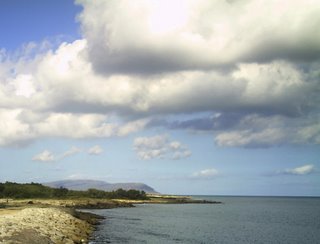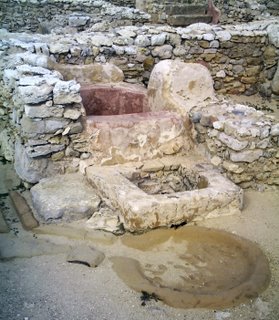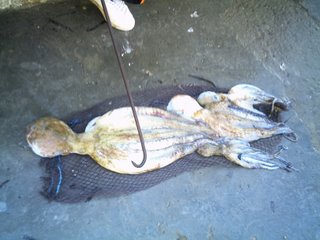Le Cap Bon
 Agricultural Production
Agricultural ProductionIn northeast Tunisia, Le Cap Bon, literally the Good Cape, has been valuable to Tunisia. Privileged with a moderate Mediterranean climate, it is a fertile agricultural area, known for citrus fruit, cultivation, particularly oranges and lemons, as well as truck farming. The isthmus is also the center of Tunisian grape growing and produces some of the best Tunisian wines, such as the Bou Argoub red (a blend of caregnane and syrah varieties) or Kelibia Muscat. Viticulture dates to antiquity and developed under the influence of the Phoenicians, Carthaginians, and Romans–and more recently les Français (the French). Arrays of olive trees over gently sloping, well-tilled hills complete my image of the perfect Mediterranean landscape. Until recently, agriculture was the sole mainstay of the area
Nature is the Spectacle
On Cap Bon, nature is the major attraction. My spirit expanded as I looked at a rural landscape of plowed fields, farms, undulating hills, and eventually a more rugged and craggy coast. Passing El Haouria at the northernmost point and following the shoreline on the Korbous side of the Cape, the seaboard becomes even rougher and the countryside greener with patches of forest. Poverty, or at least a lower standard of living, is apparent throughout the area. Although there are small tractors, donkeys and horses are often used in daily labor. Sheep and cows graze in open fields. People are seen carrying loads of firewood. Women, especially, dress in more traditional clothing. Some litter and disrepair appear at the fringes of cities and cultivated fields. Here I could get a taste of how Tunisians really live away from the mammoth complexes raised for purposes of the tourist trade.
History

The peninsula has been the theater of many invasions from Caesar to Rommel. It’s amazing to think of all the leaders and civilizations that have extended their reach into North Africa. The only ones with the most lasting influence seem to have been the Arabs and then the Turks. Morocco, however, was never part of the Ottoman Empire. Approaching the Cape, most passed by the city of Suleiman, the port of entry from Tunis. The city itself, though, was founded “only” in 1600 AD. I started out from the other side, leaving from Hammamet, and stopped first at the enormous and impressive hilltop fortress at Kelibia. The nearby town and defensive structure has existed here since Phoenician times. The Byzantines built the current citadel in the 6th century, which the Spanish badly damaged and rebuilt in the 16th century. Constructed on a colossal cliff (254 feet), it protected the port and the strait of Sicily. Nowadays, the walk around the top of the ramparts offers a superb view seaward and over the white, blue-trimmed city below.
At Kerkouane, I saw Punic ruins from the 6th century BC. Unlike other such ruins, the Romans, who abandoned the site after its destruction in the second century BC, have not altered these. The city lived principally from the production of purple dye. The ruins, not so spectacular in themselves, demonstrate the existence of homes comfortable for the times, with bathtubs, washbasins, and drainage. Here the waterfront is rocky. A wide, cement barrier, bordered by feathery bushes and the sea provided a wonderful walkway back from the location. Mosaics in the museum depict Tanit, a goddess of fertility, and protector of the city.
 El Haouaria is the city on the Cape closest to Europe. A rocky coastline, cliffs along the shore, white-capped waves, chalk quarries from which the Phoenicians built the first Carthage, an offshore island vista, all provide a refreshing break from the hectic cities of modern life and the super-sized, standardized tourist areas along Tunisia’s southern coast.
El Haouaria is the city on the Cape closest to Europe. A rocky coastline, cliffs along the shore, white-capped waves, chalk quarries from which the Phoenicians built the first Carthage, an offshore island vista, all provide a refreshing break from the hectic cities of modern life and the super-sized, standardized tourist areas along Tunisia’s southern coast.The town has an annual falcon festival. Grottos, which contain ancient quarries, were closed. A compression plant, on the line that transports natural gas from Algeria to Italy, lies, on the coast just outside El Haouaria.
Korbous is known for its thermal waters; and they are hot to the touch (at least 77˚F) as they pour out from holes in the rocky coastline. On the tree-covered, stony, steep cliffs, families are picnicking as you approach the area. The spring waters I went to were alleged to be therapeutic for rheumatism. As I approached the wooden stairway leading to the steamy basins, not to mention the sea, below, young men were displaying their catches of squid, starfish, and other piscatorial specimens. Below, women and children soaked their feet and legs in round stone caldrons, while the men bathed in the sauna-like spray over the sea below.
 Yasmine-Hammamet, an entirely new city south of Hammamet itself, was a disappointment to me. Touted as a city for the 21st century, it seemed like a huge mall of hotels with the boutiques, fast food places, small restaurants, casinos, spas, discotheques, Carthago (a theme park), and golf courses to support them. Certainly, there are some fabulous five-star hotels with all the usual comforts. Additionally, there are new villas, apartment buildings, and time-share bungalows. Here an empire of tourism and money reigns. A bit of Disneyland, along with a spanking clean, new environment and beaches at your feet or just across the corniche. I found it too unreal, too detached from reality. No intimate spaces connected to culture and history or enough green spaces and connection to nature. The future will probably prove that it’s mass tourism at its best.
Yasmine-Hammamet, an entirely new city south of Hammamet itself, was a disappointment to me. Touted as a city for the 21st century, it seemed like a huge mall of hotels with the boutiques, fast food places, small restaurants, casinos, spas, discotheques, Carthago (a theme park), and golf courses to support them. Certainly, there are some fabulous five-star hotels with all the usual comforts. Additionally, there are new villas, apartment buildings, and time-share bungalows. Here an empire of tourism and money reigns. A bit of Disneyland, along with a spanking clean, new environment and beaches at your feet or just across the corniche. I found it too unreal, too detached from reality. No intimate spaces connected to culture and history or enough green spaces and connection to nature. The future will probably prove that it’s mass tourism at its best. Tunisia is working hard to meet the challenges of a global economy and meet the challenges presented by the West and lately the rising economies of the East. Of the Maghreb countries, Tunisia is at the forefront in this effort. Yet, looking at the long span of North African history, I wonder how deeply these new ideas are penetrating, whether they are entering the mentality of people, outside of a small urban elite. Charles-André Julien states that, in spite of the fact that North Africans have continually mixed external influences with their own customs and business, the Maghreb has always remained fiercely itself. It submits to the physical domination of outsiders, without internalizing their moral or philosophical imprint. Unification has usually been accomplished under strong leadership. Never, except under the Sanhaja, has the area been free to pursue and develop an autonomous civilization. It is interesting to see how these trends are at play today.


0 Comments:
Post a Comment
<< Home